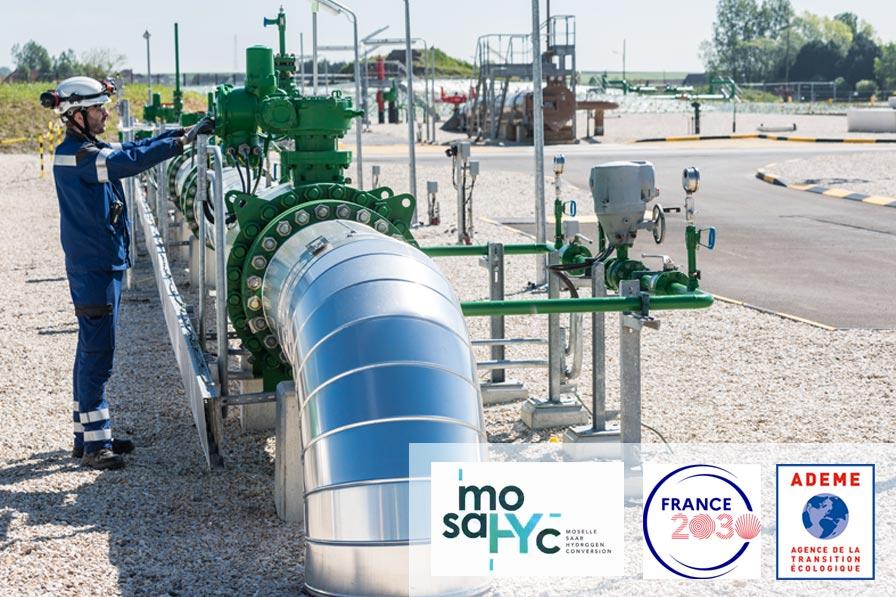Hydrogen: GRTgaz receives support from the ADEME for the MosaHYc project

The French Environment and Energy Management Agency (ADEME) is supporting the MosaHYc (Moselle Sarre Hydrogen Conversion) project. Led by GRTgaz in the Grand-Est region, the project is the future backbone of the “Grande Region Hydrogen” between France, Germany and Luxembourg. This support is a mark of recognition for a trailblazing project and a major innovation: converting the gas networks to hydrogen.
“This support is another step towards the French State recognising the importance of an open, shared means of hydrogen transport, It also shows that ADEME considers the conversion of existing gas networks to hydrogen – an innovation and ambition championed by GRTgaz – to be a promising prospect.Geoffroy Anger
Head of Hydrogen Development at GRTgaz
The MosaHYc project was selected in October 2022 as part of a Call for Projects named “Investments for the Future” launched by ADEME, France’s agency in charge of the ecological transition. The partnership with GRTgaz was formalised in May. ADEME will provide financial support for the project, from its study and R&D phase through to its first years of operation. “This support is another step towards the French State recognising the importance of an open, shared means of hydrogen transport,” says Geoffroy Anger, Head of Hydrogen Development at GRTgaz. “It also shows that ADEME considers the conversion of existing gas networks to hydrogen – an innovation and ambition championed by GRTgaz – to be a promising prospect.”
MosaHYc is currently the world’s largest cross-border project to covert gas pipelines to hydrogen. Its route includes 45 km of pipelines to be converted on the French side, and approximately 30 km on the German side. ADEME’s assistance will be used to finance part of the many studies to be carried out over a 10-year period. While MosaHYc is a commercial first-of-a-kind, it also aims to become the first demonstrator for the conversion of pipelines, the potential of which is immense. According to the European Hydrogen Backbone (EHB) consortium, the hydrogen transmission network could reach 53,000 km by 2040 in Europe, 60% of which will be made up of existing converted gas networks1. The hydrogen transmission network in France could reach 4,000 km between 2040 and 2050.
1 Source: European Hydrogen Backbone (EHB) website
Pipeline conversions: the benefits
The benefits of converting pipelines are twofold.
- First, environmental, as converting existing structures rather than building new ones shortens the construction phase, reducing CO2 emissions.
- Second, economic, as a converted section requires three to four times less investment than a new network of equivalent length, according to GRTgaz estimates.
Before reaching this point, however, GRTgaz must analyse, understand and classify all aspects of the mass transmission of hydrogen via pipelines, as well as the conversion process. This is for good reason: no open, shared hydrogen transmission network currently exists. All the benchmarks in this field are yet to be created.
Four obstacles to overcome
“ADEME’s support confirms that we were right to structure our work around four priority areas,” explains Geoffroy Anger. The first concerns the integrity of the pipes. “We need to analyse the changes to the physical resistance of the structures’ steel in a hydrogen environment,” explains Geoffroy Anger. The teams are carrying out experiments and producing models to better understand and anticipate the future impact of hydrogen in the infrastructure.
The second priority area is sealing. “Since hydrogen is a much smaller molecule than methane, we check that all the equipment currently sealed, such as valves or block valve stations, remain sealed for hydrogen, and plan any adaptations accordingly,” explains Geoffroy Anger.
The third is the quality of the hydrogen transported and the metering of the volumes transported and delivered. Current gas meters are not suitable for hydrogen, so they need to be redesigned and certified. “Regarding the quality of the gas, it is vital to know how to measure the impurity rate accurately, both for industrial and invoicing reasons.”
The final priority area is safety and hazard studies. GRTgaz is conducting a thorough study of the risks of transporting hydrogen by pipeline. The aim is to define and calibrate the models and hazard studies that will act as a reference and a means to obtain operating permits.
“We gather all the knowledge to examine all the questions and arrive at replicable models and methods, benchmarks and standards,” summarises Geoffroy Anger. “This first converted pipeline will be used as the reference for future conversion operations.”
Commissioning scheduled for 2027
So where does the project stand now? In 2021 and 2022, GRTgaz carried out several internal inspections – so-called “pistonnages” (pipeline pressure tests) – of the 45 kilometres of pipes to be converted on the French side. The results are currently being analysed at GRTgaz’s dedicated site in Compiègne. This phase, which is expected to last until September 2023, will allow GRTgaz to understand and characterise the most common defects. It can then quantify the investment needed to carry out the full conversion of the route. The MosaHYc network is scheduled to be commissioned in 2027.
To go further

Hydrogen: launch of the mosaHYc project
